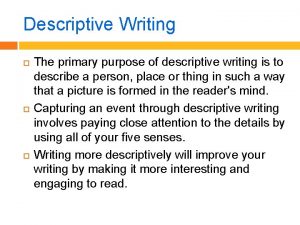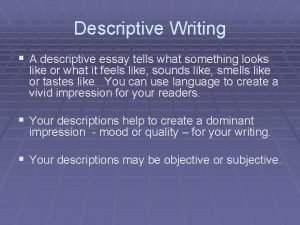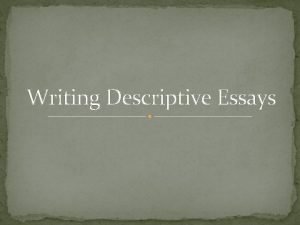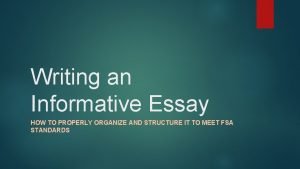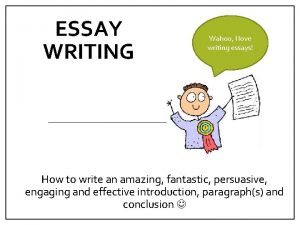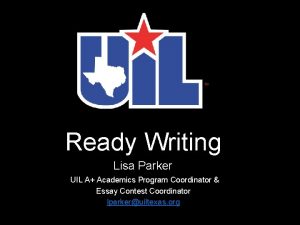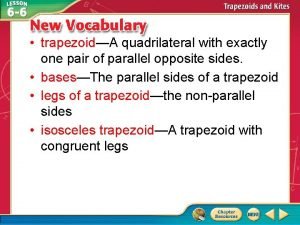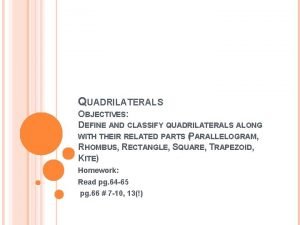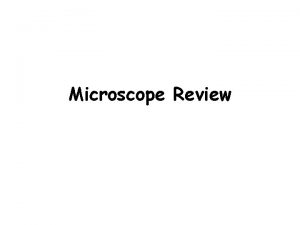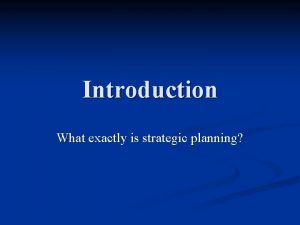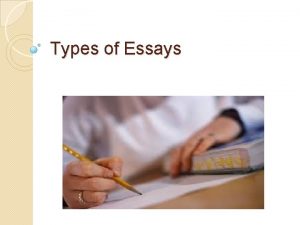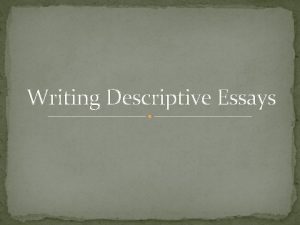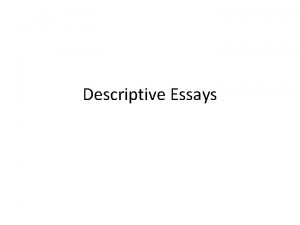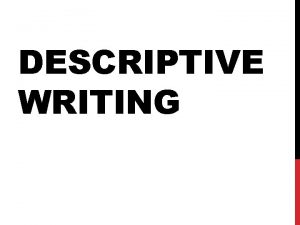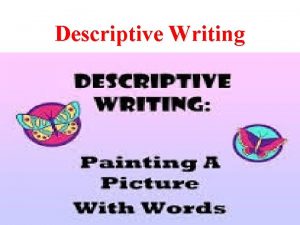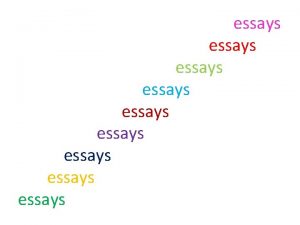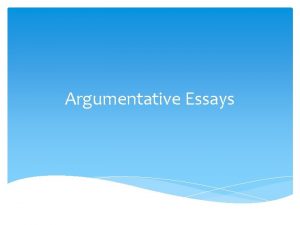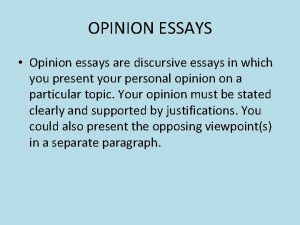Writing Descriptive Essays What exactly is a Descriptive














- Slides: 14

Writing Descriptive Essays

What, exactly, is a Descriptive Essay? A descriptive essay is simply an essay that describes something or someone by appealing to the reader’s senses: sight, sound, touch, smell, and taste.

Steps to writing an effective Descriptive Essay: 1. Select a subject - Observation is the key to writing a good description. For example, if you are writing about a place, go there and take notes on the sights, sounds, and smells. A descriptive essay paints a picture for the reader, using descriptive devices and the senses.

2. Create a thesis statement – A thesis statement is simply a sentence that tells the reader what you are going to be talking about throughout the entire essay • You’re thesis statement should never begin with phrases like, “I am going to be talking about. . . ”

• Since this is a descriptive essay, create a thesis that informs the reader of who or what you will be describing. Ex: “My bedroom is an ocean sanctuary” Ex: “My family vacation to Disney World was a magical week of fun, laughter, and sun-filled happiness.

Select dominant details - Make sure you are only writing about things that specifically support your thesis. 3. For example, if your thesis statement is talking about your sun-filled trip to the beach, don’t bore the reader with meaningless details about your swimsuit. . . You should be describing the beach itself, and perhaps some of the events that took place there (e. g. building a sandcastle, boogie-boarding, parasailing, etc. )

4. Use descriptive words – do not use vague words or generalities (such as good, nice, bad, or even beautiful). • Think about it. . . Which sounds better? “I ate a good dinner. ” Or “I devoured a steaming hot, cheese-filled pepperoni pizza for dinner. ” See the difference?

5. Provide sensory detail - Smells that are in the air (the aroma of freshly brewed coffee) - Sounds (traffic, honking horns, waves crashing) - Sights (“The sun scattered tiny diamonds across dewcovered grass as it peeked out from beyond the horizon. ”) - Touch (“The texture of the adobe hut’s walls resembled coarse sandpaper. ”) - Taste: sweet, sour, salty, bitter, tart (“Giant goose bumps formed on my tongue when I accidently bit into a sliver of lemon. ”)

6. Draw a logical conclusion - The conclusion may also use descriptive words; however, make certain the conclusion is logical and relevant.

Now let’s practice! On a blank sheet of paper, look at the following images. Write down things you might hear, see, taste, smell, or feel/touch if you were “in” these pictures After you have compiled a brief list of sensory details, write a descriptive sentence about each picture.




 Descriptive writing purpose
Descriptive writing purpose Whats a descriptive essay
Whats a descriptive essay Descriptive essays
Descriptive essays How to write informative essay
How to write informative essay Advantages and disadvantages of writing essays
Advantages and disadvantages of writing essays I love writing essays
I love writing essays Uil ready writing winning essays
Uil ready writing winning essays A quadrilateral with exactly one pair of parallel sides.
A quadrilateral with exactly one pair of parallel sides. Quadrilateral that has 2 pairs of parallel sides
Quadrilateral that has 2 pairs of parallel sides How many planes does a pyramid have
How many planes does a pyramid have Human resources and job design
Human resources and job design Name
Name What exactly is a strategy
What exactly is a strategy What is logistics management
What is logistics management When does james gatz change his name? why?
When does james gatz change his name? why?
